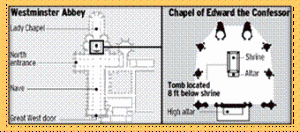Several archaeological projects with the potential of revealing answers to some of England’s medieval mysteries have been in the news and are worth mentioning here for my fellow medieval history buffs and writers.
Earlier this fall I posted a piece on medieval mortuary chests and the project I witnessed that’s underway in Winchester Cathedral. As I posted, this project is focusing on assigning specific identities to the bones of Wessex’s early monarchs and bishops; remains that were carelessly ‘dumped’ into assorted chests by Oliver Cromwell’s troops. No easy feat for present day archaeological detectives!
As this project proceeds, up north in Leicester a major ‘accidental’ discovery hit the news just as I was returning from England in mid September. In late August, while working on a dig under a city car park, workers discovered skeletal remains with spinal abnormalities and a “cleaved-in skull.” Archaeological authorities called in from Leicester University ‘suggest’ these remains could be those of King Richard III, the last of the Plantagenet kings, who died in 1485 during the battle of Bosworth, England’s last of significance, in its ‘War of the Roses’.
Prior to his demise at Bosworth, Richard’s climb to the throne is a story full of complexities, family rivalries, evil doings and political maneuverings, not the least of which are suspicions that he ordered the murder of his two young nephews in the Tower, thus eliminating any rival claims to the throne.
As a defeated enemy of Henry Tudor, founder of the Tudor dynasty, Richard was given a low-key burial in the Franciscan friary of Greyfriars. Although demolished in the 1530’s, there’s evidence that his burial site survived. If DNA testing against descendants of Richard’s family confirm the current archaeological theories, this would be a remarkable discovery. Additional controversy has also surfaced regarding a suitable burial place for the remains, should they be Richard’s. Earlier this week after various news reports concerning this issue, it was revealed that should speculations be confirmed, Richard’s remains would be interred in Leicester’s cathedral…but that was this week. We shall see.
And, although not as recent as the discoveries in Winchester and Leicester, there’s more. In 2005 the London press reported that along with the discovery of 13th and 14th century royal tombs, work using radar in London’s Westminster Cathedral, pinpointed the original tomb of King Edward the Confessor, one of the most revered of British saints and one of the last Saxon kings, who died months before the Battle of Hastings in 1066.
Until this discovery it was assumed that Edward’s tomb was placed near Westminster’s current high altar as implied in medieval records. However, further research revealed this was not the case. In 1269, King Henry III had a shrine built to honor and contain Edward’s remains. He also had the altar moved and with it, Edward’s tomb which he had placed it under the shrine. Today, the shrine rests approximately ten feet behind the present high altar. Edward as a king does not hold a high place in history as some of his more famous peers, but nevertheless, his presence has endured. Although made long after his death, the main royal crown is called St. Edward’s Crown and the Coronation Chair is sometimes called St Edward’s chair.
His family was of the Wessex dynasty and when his half brother, Hardecanute, died in 1042, Edward was named king. He was then succeeded by Harold, killed in the Battle of Hastings, which then ushered in the reign of William the Conqueror and the Normans. After Hastings, Edward’s reputation for piety grew…Pope Alexander III canonized him in 1161 and for four hundred years he was considered the patron saint of England until 1415 when this status was replaced by St. George.
Happily the advent of 21st century technology is allowing us fascinating peeps into the ancient past with the prospect of solving mysteries that have mystified many of us for years!
Inquiring minds want to know: what is your favorite medieval legend that remains unsolved? Is it Arthur, the ‘Princes in the Tower’ or perhaps…???
YOU CAN FOLLOW ME ON: https://www.facebook.com/gayemackauthor OR https://www.twitter.com/gayemack


1817 wasn’t medieval, but I’m wondering if there is any interest by the powers that be in England in digging up Jane Austen’s bones just long enough to do a cat scan, take some measurements, and maybe take a DNA sample. There is so much interest in what she looked like, that I think a lot of people would want to see a facial reconstruction tried.
Thanks for the question! Since this isn’t my time frame I went to a group of English historical fiction authors with whom I network and asked about this…the consensus is no– as far as they were concerned(especially the Brits!)…None felt that exploring this idea falls in the same realm as the interest in identifying remains during other excavations such as Richard III and now, Alfred of Wessex. Hope this helps!!